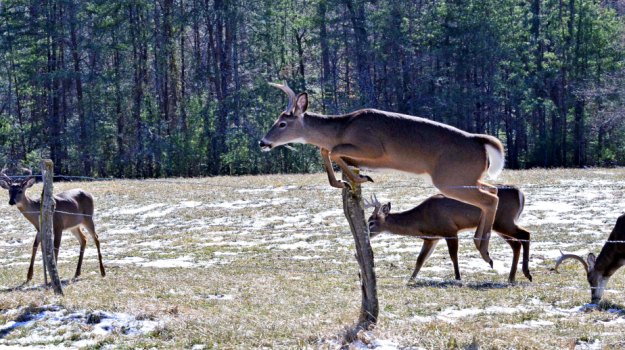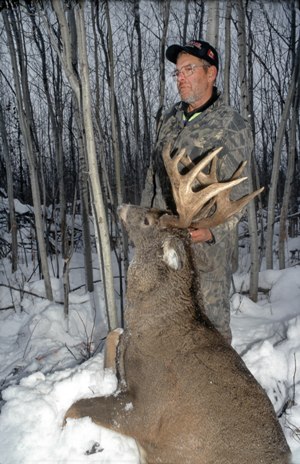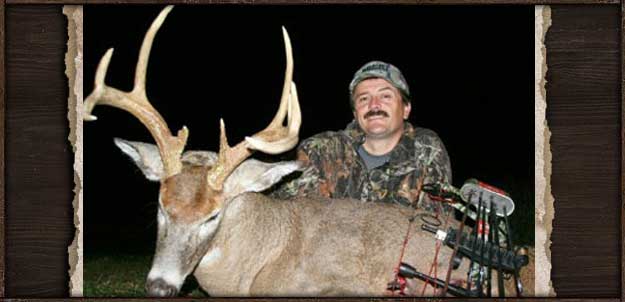
Editor’s Note: Fifty-one year old Joe Shults of Newport, Tennessee, is a member of the PSE Pro Staff and a member of the Drury Outdoors “Dream Season: The Journey” TV show. When Shults was out of work due to a factory closing, he hunted and fished often. He realized there wasn’t a sporting-goods store for miles from his home, so he opened one. Shults explains, “I've been wearing Mossy Oak since 1990.”
Since I've been hunting, I've taken 17 bucks that score 150 or better. I took a really nice buck in Wisconsin with an inside spread of his main beams scoring 24-1/8-inches but without much tine length. So, he only scored 167 on Pope & Young. I’d seen this buck the day before I actually took him on a morning hunt. The buck was returning from feeding and was going to his bed. Before this buck came out of that field where he could see the entire field, he studied the timber with his eyes and into the timber where his vision would be limited. We were 20 yards inside the timber. This buck was very cautious. He looked right up in the tree at me and my cameraman two or three different times. I whispered to Scotty Blair, my cameraman, “I'm afraid this buck is going to pick us out, and I won’t have a chance to shoot him.” Scotty and I stayed as still as possible in our Mossy Oak from head to toe. Finally, the buck came on into the timber where we were, so I could take him. Our Mossy Oak camouflage allowed us to blend into the tree, and the buck couldn’t see us and identify us as hunters.
 The real secret to taking mature bucks when they're in close is to not move or panic. Often a deer will look straight at a hunter for a long time and put his head down like he's going to feed. Then, he’ll jerk his head up quickly to see if the hunter has moved. If you reach for your bow or your gun when a big buck is close, if he’s been staring at you and finally lowers his head toward the ground, when he jerks his head up quickly to look at you again, he’ll spot you. Most hunters are so afraid that a big buck will leave an area before they can get their rifles to their shoulders or pick up their bows that they move too quickly and the deer sees them. So, always watch the deer’s eyes.
The real secret to taking mature bucks when they're in close is to not move or panic. Often a deer will look straight at a hunter for a long time and put his head down like he's going to feed. Then, he’ll jerk his head up quickly to see if the hunter has moved. If you reach for your bow or your gun when a big buck is close, if he’s been staring at you and finally lowers his head toward the ground, when he jerks his head up quickly to look at you again, he’ll spot you. Most hunters are so afraid that a big buck will leave an area before they can get their rifles to their shoulders or pick up their bows that they move too quickly and the deer sees them. So, always watch the deer’s eyes.
Defensive backs have learned over the years to watch the quarterback’s eyes. When he drops back to pass, the quarterback’s eyes tell the defensive backs where he’ll throw the pass. Just before the quarterback cocks his arm to throw the pass, he has to see the receiver in his peripheral vision or look straight at the receiver. Just like this, the deer’s eyes will tell you what he's going to do. If a deer has been staring at you and lowers his head like he's starting to feed - watch his eyes. If his eyes aren’t looking straight down at the ground but are looking off to the side of his head, that buck is watching you in his peripheral vision. A deer’s peripheral vision is much better than ours. If you're watching a buck’s eyes when he drops his head, he’ll start rooting around in the leaves for an acorn or something to eat and drop his eyes from looking out the side of his head to looking at the side of his nose. That’s when you pick up your bow and come to full draw or bring your gun to your shoulder. When you can’t see the buck’s pupils in his eyes, that’s your signal to make whatever movement you need to make to get the shot. I think many hunters don’t understand how effective an older-age-class buck’s peripheral vision can be. But like the defensive lineman on a football team, If you'll watch the deer’s eyes, you'll soon learn when you can and can’t move.






























